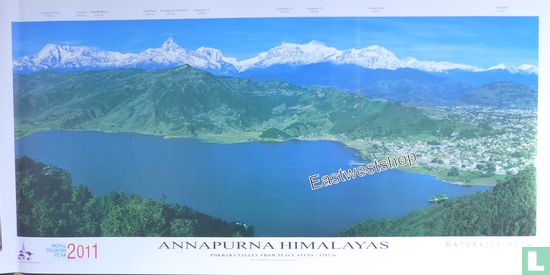Enlarge image
Nepal Annapurna Himalaya from Pokhara . Toerisme Poster
Catalogue information
LastDodo number
4601161
Area
Poster
Title
Nepal Annapurna Himalaya from Pokhara . Toerisme Poster
Type
Sub-series
Event location
Designer
Publisher
Year
2011
Number produced
Numbering off
Numbering to
Signature
Language
Country
Theme
Printing technique
Colouring
Dimensions
75.0 x 37.0 cm
Details
Tourism promotional poster Nepal Himalya
( for travel agency, airport, tourist fair ..)
Annapurna Himalaya
Pokhara Valley from Peace Stupa : Annapurna South (7129M)
Hiunchuli (6441) Annapurna I (8091)
Mardi Himal (5588) Machhapucchhre (6993) Annapurna III (7555) Annapurna 4 (7525) Annapurna 2 (7939) Lamjung Himal (6932)
Manaslu (8163)
Annapurna (Sanskrit, Nepali, Nepal Bhasa: अन्नपुर्ण) is a section of the Himalayas in north-central Nepal that includes 8,091 m (26,545 ft) Annapurna I, thirteen additional peaks over 7,000 m (22,970 ft) and 16 more over 6,000 m (19,690 ft).[3] This section is a 55 km-long (34 mi-long) massif bounded by the Kali Gandaki Gorge on the west, the Marshyangdi River on the north and east, and Pokhara Valley on the south. Annapurna I is tenth among Earth's fourteen eight-thousanders. 8167 metre Dhaulagiri I rises 34 km to the west across the Kali Gandaki Gorge, considered Earth's deepest canyon.
Annapurna is a Sanskrit name which literally means "full of food" (feminine form), but is normally translated as Goddess of the Harvests. In Hinduism, Annapurna is "... the universal and timeless kitchen-goddess ... the mother who feeds. Without her there is starvation, a universal fear: This makes Annapurna a universal goddess ... Her most popular shrine is located in Kashi, on the banks of the river Ganga." Her association with the giving of food (wealth) led her in time to be transformed into Lakshmi, the Goddess of Wealth.[4]
The entire massif and surrounding area are protected within the 7,629 km2 Annapurna Conservation Area, the first and largest conservation area in Nepal. The Annapurna Conservation Area is home to several world-class treks, including the Annapurna Circuit.
The Annapurna peaks are among the world's most dangerous mountains to climb, although in more recent history, using figures from only 1990 and after, Kangchenjunga has a higher fatality rate.[5] As of the end of 2009, there had been 157 summit ascents of Annapurna I, and 60 climbing fatalities on the mountain.[6] This fatality-to-summit ratio (38%) is the highest of any of the eight-thousanders.

